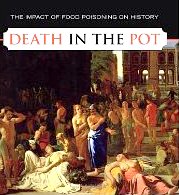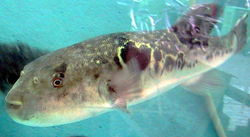
The modern world is filled with people who gratefully and ravenously eat anything. In fact, much of history is fundamentally a search for secure sources of food. Governments may well declare "food safety" among their primary missions, yet some of their citizens will nonetheless sicken and die. Many more will fret, needlessly.
 Morton Satin, PhD in molecular biology, a former director inside the Food & Agrlculture Organization of the United Nations (he ran their Global Agribusiness Program), wrote a book about this some years ago. Titled Death in the Pot, it surveys the impact of food poisoning on history. (The title is from 2 Kings 4:38-41, so you know it's a long history.)
Morton Satin, PhD in molecular biology, a former director inside the Food & Agrlculture Organization of the United Nations (he ran their Global Agribusiness Program), wrote a book about this some years ago. Titled Death in the Pot, it surveys the impact of food poisoning on history. (The title is from 2 Kings 4:38-41, so you know it's a long history.)
Much was misunderstood. The madness of King George III was probably due to arsenic poisoning. In the meantime, as Satin describes, ingesting moldy grain could produce manifestations ascribed to witchcraft. Indeed the fungus known as Claviceps purpurea, which we call ergot, produces hallucingenic consequences described as St. Vitus Fire. (Yes, an ergot derivative is used to treat Parkinson's disease, but vastly increases the risk of leaky heart valves.) Outbreaks of mass hysteria, wherever they were recorded, could have been nothing more than ergot poisoning. As recently as 1951, in Pont-St.-Esprit in southern France, the village baker used flour contaminated with ergot (not, as postulated, mercury) to make his baguettes. Le pain maudit sickened hundreds (leaping from windows, seeing visions) and killed four townspeople.
Not until the 13th century was agriculture revolutionized by the invention of what we now think of as the "modern" (moldboard) plow that boosted production by aerating the soil and allowing for more secure germination of grains.The population of western Europe doubled.as a result. Then, during a century of wars, unusual frosts and plagues, it plunged again. Some centuries later, the phytophthora infestans fungus devastated the Irish potato crop; in the ensuing famine, Ireland's population fell from eight to five million people, and the resulting swarm of Irish immigrants had an enormous impact on the rest of the world.
By the middle of the 19th century, food preservation methods included the process we now call canning. Alas, improperly soldered cans poisoned a British expedition that set out to discover the elusive Northwest Passage. There were no survivors.
Nor is it all in the past. As recently as 2001, a number of rat-poisoning incidents began to surface in China. There's a backstory, involving the British East India Company and its promotion of opium. The deep-water harbor of Hong Kong, then a sleepy island of fisherman, became the flash point. Humiliated by the British, the Chinese retaliated by poisoning Hong Kong's entire bread supply (consumed only by non-Chinese) with arsenic. Fortunately, the perpetrator got the dose wrong, and very few victims died.
Parenthetically, the US government did not always regulate food safety. During the Spanish-American war, unscrupulous purveyors sent "meat" laced with borax, formaldehyde and copper sulfate to the troops on the front lines. Similar preservatives were common in civilian food as well. It wasn't until the second half of the 19th Century that there were reliable tests for arsenic.
Even so, in 1937 a Tennessee comapny, Masengill, produced a drug called Elixir Sulfanilamide to combat streptococcal infections. The active ingredient was dissolved in a raspberry-flavored diethylene glycol, sold without a prescription. Dozens of people, many of them children, died. In the ensuing public outrage, the US Food & Drug Adminstration came into existence.
In the 1930s, a company called Nippon Chisso built a fertilizer factory on Kyushu Island. In the process of making acetaldehyde, acetylene is passed over a catalyst of mercury sulfate; the waste products were dumped into the nearby waters of Minamata Bay. For the next four decades, Chisso continued to dump effluent into the bay. LIFE magazine published a photograph, in 1972, of a woman afflicted with mercury poisoning, but it was not until 2005 that Chisso finally acknowledged its responsibility and stopped production.
In Spain, in 2001, thousands were sicked and nearly 2,000 people died after consuming contaminated rapeseed oil. In 1985, a quantity of Austrian wine was found to be adulterated with diethylene glycol (antifreeze). The following year, methanol was discovered in wines from Piedmont; 25 people died. In 1998, 80 people died in Kenya after drinking methanol-laced whiskey. In Estonia, in 2001, 67 died after drinking vodka laced with methanol.
 Then there's fugu, the Japanese poisonous puffer fish. And E. coli, which turned up in the Jack In The Box cheeseburger that killed young Michael James of Tacoma in 1993. Thirteen years later, another E.coli outbreak, in spinach, finally prompted an overhaul of food safety laws in the US.
Then there's fugu, the Japanese poisonous puffer fish. And E. coli, which turned up in the Jack In The Box cheeseburger that killed young Michael James of Tacoma in 1993. Thirteen years later, another E.coli outbreak, in spinach, finally prompted an overhaul of food safety laws in the US.
Remember Bagwan Shree Rajneesh and his communie in eastern Oregon? His deputy, a woman named Ma Anand Sheela, hatched a plan to contimate the neighbors with salmonella she ordered through the mail. The freeze-dried disks were duly delivered, and two Wasco County commissioners poisoned.
In 1978, a Soviet dissident living in London, Georgi Markov, was fatally infected with toxic ricin, stabbed by the KGB with a hollow-pointed umbrella. In 2004, a candidate for the presidency of Ukraine, Viktor Yushchenko, was fed a near-fatal level of dioxin at a dinner meeting with security agents in Kiev; he was badly disfigured but recovered. A Russian dissident Alexander Litvinenko was not so fotruate. In 2006, in London, he ingested radioactive polonium and perished; a KGB agent was indicted.
What more can we add? You certainly should watch what you eat, and not just because it makes your butt look big. Dr. Satin spends his time these days defending the virtues of salt (as VP Research for the Salt Institute), a more challenging job, no doubt, than tracing the lives of the great poisoners.
Death in the Pot, Prometheus Books, 259 pages, from $22.81
Leave a comment